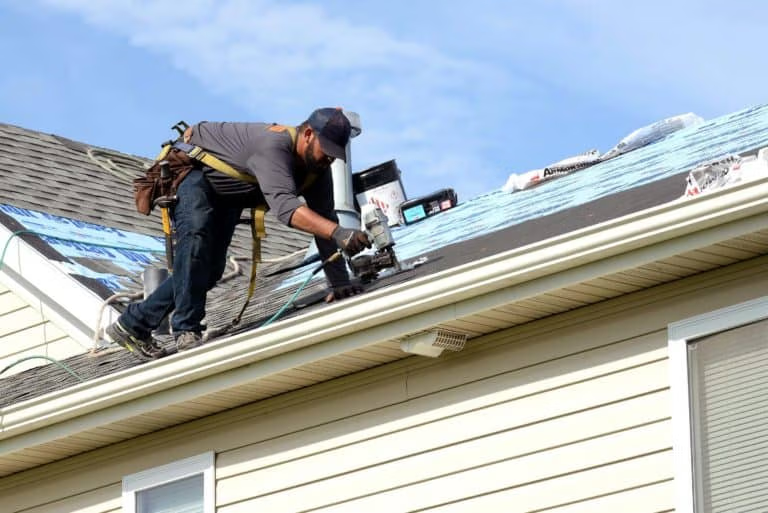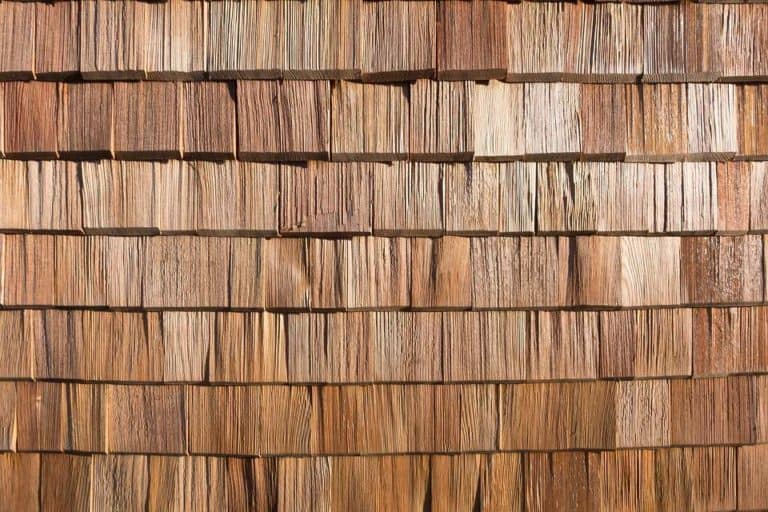Frequently Asked Questions
Can I repair a flat roof bubble in the winter?
While it is possible to repair flat roof blisters in the winter, the process may be more challenging. Colder temperatures can make the roofing materials less pliable, requiring extra care during the repair. It is recommended to schedule flat roof blister repairs during warmer months when conditions are more favorable.
How do you inspect a flat roof for blisters?
To inspect a flat roof for blisters:
Visually examine the roof surface for any bubbling or raised areas.
Gently press on suspect areas to check for soft spots or lack of adhesion.
Cut into any blisters to determine the extent of the damage and underlying cause.
What are the consequences of ignoring flat roof blisters?
Ignoring flat roof blisters can lead to further deterioration, leaks, and potential structural damage. Addressing blisters promptly is important to prevent more extensive and costly repairs down the line.
How do you identify the source of a blister on a flat roof?
To identify the source of a blister on a flat roof, inspect the area for cracks, peeling, or gaps. Clean and cut the blister in the middle, cutting the top layer without damaging the underlying felt.
Are flat roof blisters a sign of poor installation?
Flat roof blisters can be a sign of poor installation or improper ventilation. They occur when air or moisture becomes trapped between roof layers, causing the top layer to lift and form bubbles. Addressing the root cause is crucial for effective flat roof repair.
Are flat roof blisters a sign of roof aging?
Flat roof blisters can be a sign of roof aging, as they often develop due to deterioration of the roofing materials over time. Addressing blisters promptly can help extend the lifespan of a flat roof.
Can I repair a flat roof bubble myself?
Yes, minor flat roof blisters can often be repaired yourself. First, clean and cut the blister area. Then, apply roof sealant or patch material to the affected spot. For larger or more extensive issues, it's best to consult a professional roofer.
What causes bubbles to form on a flat roof?
Flat roof blisters or bubbles can form due to a few common reasons: moisture trapped between roof layers, poor installation, age and deterioration of the roof system, or improper ventilation. Addressing the underlying cause is key to repairing flat roof blisters.
Can blisters on a flat roof cause leaks?
Yes, blisters on a flat roof can lead to leaks. Blisters allow water to penetrate the roof membrane, resulting in potential moisture damage and leaks if left unrepaired.
How long does a flat roof bubble repair last?
The lifespan of a flat roof bubble repair can vary depending on factors like the extent of the damage, the repair method used, and ongoing maintenance. Generally, a properly executed flat roof bubble repair can last 5-10 years before requiring additional attention.
Can improper drainage cause flat roof blisters?
Yes, improper drainage can lead to the formation of flat roof blisters. Standing water on a flat roof creates moisture buildup, which can cause the roofing materials to bubble and blister over time.
What is the process for flat roof bubble repair?
To repair flat roof blisters:
Locate and clean the bubble area.
Cut the blister in the middle, taking care not to cut through the felt.
Apply sealant or roof cement to the cut edges to prevent further damage.
Can a bubble on a flat roof cause leaks?
Yes, blisters or bubbles on a flat roof can lead to leaks if not addressed. The bubbles create gaps and cracks that allow water to seep through, potentially causing damage to the roof structure.
What causes blisters to form on a flat roof?
Blisters on flat roofs can form due to trapped moisture or air between the roofing layers. This causes the top layer to separate and create a bubble or blister. Cutting and repairing the area is typically required to fix blistering issues on flat roofs.
How does weather affect a flat roof bubble repair?
Flat roof bubble repair is affected by weather in several ways: 1) Moisture and humidity can impact adhesion of repair materials. 2) Extreme temperatures, either hot or cold, can cause expansion/contraction and affect the repair. 3) Wind and precipitation can disrupt the repair process.
Can I use silicone to repair a flat roof bubble?
Yes, you can use silicone to repair a flat roof bubble. Silicone is a flexible sealant that can effectively fill and seal roof blisters or bubbles. First, clean the area around the bubble, cut it open, and apply a generous amount of silicone to the affected spot.
Can I repair a flat roof blister myself?
Yes, you can repair flat roof blisters yourself. First, locate and clean the affected area. Then, cut the blister in the middle, taking care not to cut through the felt. This will allow the trapped moisture to escape and the blister to be sealed.
How much does it cost to repair a flat roof bubble?
The cost to repair a flat roof bubble can vary significantly depending on the size and extent of the damage. Typical flat roof bubble repair costs range from $100 to $500 per occurrence, with the average being around $300.
Can flat roof blistering lead to roof collapse?
Yes, flat roof blistering can lead to roof collapse if left unaddressed. Blisters indicate moisture trapped between roofing layers, which can progressively weaken the roof structure over time and result in a total failure.
Can a flat roof bubble be repaired from the inside?
Yes, flat roof blisters or bubbles can be repaired from the inside. The process involves cleaning the area, cutting the blister in the middle without cutting through the felt, and sealing the area.
How does water infiltrate flat roof blisters?
Water can infiltrate flat roof blisters through cracks or gaps in the roofing material. The water seeps under the top layer, causing the blisters to form and expand over time.
What is the typical size of a blister on a flat roof?
Blisters on flat roofs can range in size from a few inches to several feet in diameter, depending on the extent of the roof damage. Proper inspection and repair is crucial to prevent further deterioration.
How do you fix a blister on a flat roof?
To fix a blister on a flat roof, first locate and clean the area. Then cut the blister in the middle, without cutting through the felt layer. This allows the area to be repaired.
What are the common causes of flat roof blisters?
Common causes of flat roof blisters include poor installation, moisture trapped beneath the roof membrane, exposure to UV rays, and improper ventilation. Damaged or deteriorated roofing materials can also lead to blister formation.
What are the signs of flat roof blistering?
Signs of flat roof blistering include cracking or peeling of the roof surface, formation of bubbles or blisters, and gaps or cracks around the roof edges and joints. Proper inspection is crucial to identify the extent of damage.
How do I know if my flat roof bubble is repaired correctly?
To ensure a flat roof bubble is repaired correctly:
Inspect the area for any remaining cracks or bubbling after repairs.
Check that the repaired area is properly sealed and adhered to the existing roof membrane.
Monitor the repaired area over time for any recurring issues.
What are the risks of ignoring a flat roof bubble?
Ignoring flat roof blisters can lead to further deterioration of the roofing system. Blisters allow moisture penetration, causing leaks and potential damage to the roof's structural components. Prompt repair is crucial to prevent more extensive and costly issues.
Can flat roof blisters be prevented?
Yes, flat roof blisters can be prevented by proper installation, using high-quality materials, and conducting regular inspections and maintenance. Protecting the roof from moisture intrusion is key to avoiding blisters.
Can blistering occur on an asphalt flat roof?
Yes, blistering can occur on an asphalt flat roof. Blisters form when moisture gets trapped between the roof layers, causing the top layer to separate and bubble up.
Can flat roof blistering be prevented?
Yes, flat roof blistering can be prevented. Proper roof inspection, use of high-quality materials, and regular maintenance can help identify and address issues before blisters form. Ensuring adequate roof drainage and avoiding moisture buildup are also key preventive measures.
What materials are prone to blistering on a flat roof?
Flat roofs made of built-up roofing (BUR), modified bitumen, and single-ply membranes are prone to blistering due to heat, moisture, and poor installation. Proper ventilation, material selection, and installation techniques can help prevent roof blistering.
What is the cost of repairing a flat roof blister?
The cost of repairing a flat roof blister can vary depending on the size and extent of the damage, as well as the materials and labor required. It typically ranges from $500 to $1,500 for a small to medium-sized blister repair project.
Can a roofing contractor fix a flat roof blister?
Yes, roofing contractors can typically repair flat roof blisters by cleaning the area, cutting the blister in the middle, and patching the top layer without cutting through the underlying felt.
How does UV exposure contribute to flat roof blistering?
UV exposure causes the roof membrane on flat roofs to degrade over time, leading to blistering as the top layers separate from the underlying substrate. The sun's UV rays break down the roof material, making it more susceptible to blistering.
Can EPDM roofs be prone to blistering?
Yes, EPDM roofs can be prone to blistering, particularly in hot climates. Blisters can form due to trapped moisture, improper installation, or exposure to UV radiation. Regular inspections and timely repairs are important to address blistering on EPDM roofs.
Are flat roof blisters more common in certain climates?
Flat roof blisters can occur more frequently in hot, humid climates where moisture and temperature changes can cause the roofing materials to expand and contract, leading to blister formation.
Can a flat roof bubble be prevented from forming?
Yes, flat roof bubbles can be prevented by regular inspections and timely repairs. Some key steps include:
Identifying and addressing any cracks, gaps, or openings in the roofing material before they lead to blisters.
Properly securing the roofing membrane to the underlying substrate to prevent air pockets from forming.
Using quality roofing materials designed for flat roof applications to minimize the risk of blistering.
Ensuring proper roof drainage to prevent pooling of water which can contribute to bubble formation.
What is the typical size of a flat roof blister?
Flat roof blisters can range from a few inches to several feet in diameter, depending on the size and extent of the damage. These blisters are caused by trapped moisture or air pockets under the roofing membrane.
How long does it take to repair a flat roof blister?
Repairing a flat roof blister typically takes 1-2 hours, depending on the size and location of the blister. The process involves locating the blister, cutting it open, cleaning the area, and applying sealant or patching material.
What are the signs of a failing flat roof bubble repair?
Common signs of a failing flat roof bubble repair include:
Recurring blisters or bubbles forming in the repaired area
Cracking or peeling of the sealant or patch material
Water leaks or moisture intrusion around the repaired bubble
What role does roof drainage play in blistering?
Proper roof drainage is crucial to prevent blistering. Inadequate drainage can lead to standing water, which can cause the roofing materials to separate and form blisters. Ensuring efficient water runoff is key to avoiding this issue.
How often should I inspect my flat roof for blisters?
Flat roofs should be inspected regularly, at least twice a year, for signs of blisters. Catching and repairing blisters early can prevent further damage to the roof.
What are the differences between blisters and bubbles on a flat roof?
Blisters on a flat roof are caused by trapped moisture between roof layers, while bubbles are caused by adhesive failure, allowing the roof surface to separate from the underlying roof membrane. Blisters require cutting and patching, while bubbles need the adhesive to be reactivated.
Can tree branches cause flat roof blisters?
Yes, tree branches can cause damage to flat roofs, leading to the formation of blisters. The branches can rub against the roof surface, creating cracks and tears that allow moisture to penetrate the roofing material, resulting in blisters.
What is the best material for flat roof bubble repair?
The best material for flat roof bubble repair is typically a self-adhering membrane or sealant. This can effectively seal and repair blisters or bubbles in the roof surface without requiring extensive roof replacement.
How do I fix a small bubble on my flat roof?
To fix a small bubble on a flat roof:
Locate the bubble and clean the surrounding area
Cut the bubble in the middle, taking care not to cut through the entire roofing material
Apply a roofing sealant or patch over the cut bubble to seal it
What are the benefits of timely flat roof bubble repair?
Timely flat roof bubble repair prevents further deterioration, maintains roof integrity, avoids water damage, and extends the lifespan of the roofing system. It helps maintain a weather-tight seal and protects the underlying structure.
Are flat roof blisters covered by roof warranties?
Flat roof blisters are not typically covered under roofing warranties, as they are often considered a maintenance issue rather than a defect in the roofing material. Proper roof inspection and timely repairs are necessary to address flat roof blisters.
How do I identify a bubble on my flat roof?
To identify a bubble on a flat roof, look for areas with a raised, rounded appearance on the roof surface. These bubbles are caused by trapped air or moisture between roof layers and require prompt repair to prevent further damage.
Is it necessary to repair a small flat roof bubble?
Yes, it is necessary to repair a small flat roof bubble. Unaddressed bubbles can lead to further roof damage and leaks over time. Proper inspection and repair of blisters and bubbles is crucial for maintaining the integrity of a flat roof system.
How does weather impact flat roof blistering?
Flat roof blistering is often caused by moisture trapped between the roof membrane and substrate, which expands during hot weather and creates bubbles or blisters. Proper ventilation, drainage, and material selection can help mitigate weather-related blistering.
Can I use a repair kit to fix a flat roof blister?
Yes, you can use a repair kit to fix flat roof blisters. Repair kits typically contain a sealant or patch material that can be applied to the affected area to seal and repair the blister.
Are flat roof blisters more common in certain types of roofs?
Flat roof blisters are more common in roofs with built-up asphalt or modified bitumen membrane systems. They can form due to moisture trapped between roofing layers, improper installation, or thermal expansion/contraction.
Do I need a professional to repair my flat roof bubble?
Yes, it is recommended to have a professional repair flat roof blisters or bubbles. Proper inspection, cleaning, and cutting techniques are required to address the issue effectively and prevent further damage.
How much does it cost to repair a flat roof blister?
The cost to repair a flat roof blister can vary depending on the size and severity of the issue, but generally ranges from $100 to $500 per repair. Factors like the roofing material and location of the blister can also impact the final cost.
What are the consequences of ignoring flat roof blistering?
Ignoring flat roof blistering can lead to further damage, such as cracking, peeling, and water infiltration. Blisters should be promptly repaired to prevent more extensive and costly roof repairs down the line.
Can a leaky roof cause flat roof blisters?
Yes, a leaky roof can cause flat roof blisters. Leaks allow moisture to accumulate under the roof membrane, leading to the formation of blisters or bubbles in the roofing material.
Can blistering occur on a new flat roof?
Yes, blistering can occur on a new flat roof. Blisters form when moisture gets trapped between the roof membrane and the underlying substrate, causing the membrane to bubble up. Proper installation and ventilation are important to prevent blistering on flat roofs.
What is the best material to use for flat roof blister repair?
For repairing blisters on flat roofs, the best materials are:
Sealing compound or liquid roof patch to seal cracks and prevent further damage
Reinforcing fabric or mesh to cover and strengthen the repaired area
Acrylic or silicone coating to provide a protective, waterproof layer
How do I identify a blister on my flat roof?
Blisters on a flat roof appear as raised, bubble-like areas on the roof surface. To identify them, inspect the roof for any irregular bumps, swellings, or areas that appear inflated. Carefully examine the roofing material for signs of separation or lifting.
What exacerbates flat roof blister frequency?
Factors that exacerbate flat roof blister frequency include poor roof drainage, lack of ventilation, excessive moisture intrusion, and improper installation techniques. Proper roof maintenance and timely repairs can help mitigate flat roof blister issues.
Do flat roofs require specialized blister repairs?
Yes, flat roofs often require specialized blister repairs. The lack of slope makes it more prone to blisters forming. Repairing flat roof blisters involves cleaning the area, cutting the blister in the middle, and cutting the top layer without going through the felt.
Does ponding water accelerate blister formation?
Yes, ponding water on a flat roof can accelerate the formation of blisters. Ponding water creates moisture buildup that can lead to the separation of roof layers, resulting in blisters.
How critical is blister size for repairs?
The size of blisters on a flat roof is a critical factor in determining the proper repair method. Smaller blisters may only require cleaning and patching, while larger blisters may necessitate more extensive repairs or replacement of the roofing material.
What inspection techniques reveal hidden blisters?
Thorough inspection of the roof surface can identify cracking, peeling, and gaps that may indicate the presence of hidden blisters. Locating separated seams, particularly around edges or joints, can also reveal blisters under the surface.
Should blister repairs match original roofing material?
Yes, blister repairs should match the original roofing material for best results and seamless appearance. Mismatched materials can lead to further damage and compromised roof integrity.
How quickly should one address roof blisters?
Roof blisters should be addressed promptly, as they can lead to further damage if left unrepaired. Addressing blisters quickly helps prevent moisture intrusion and potential structural issues.
Do blister patterns indicate specific damage types?
Yes, blisters on a flat roof can indicate specific types of damage. Blistering often signifies moisture trapped between roofing layers, which can lead to further deterioration over time if not addressed properly.
What maintenance prevents blistering on flat roofs?
Proper inspection to identify cracks, peeling, or gaps, and repairing blisters by cleaning the area and cutting the top layer without cutting through the felt can help prevent blistering on flat roofs.
How do temperature fluctuations affect roof blisters?
Temperature fluctuations can cause expansion and contraction of roof materials, leading to cracking and blistering. Sudden changes in temperature create stress on the roofing system, causing the top layer to separate from the underlayment and resulting in blisters.
When should professionals assess flat roof blisters?
Professionals should assess flat roof blisters as soon as they are discovered, as they can indicate underlying issues like moisture penetration or improper installation. Addressing blisters promptly can prevent further damage.
Does foot traffic contribute to roof blistering?
Yes, foot traffic can contribute to roof blistering by damaging the roof membrane and allowing moisture intrusion, leading to blister formation.
Will recoating a flat roof prevent blisters?
Recoating a flat roof can help prevent blisters by sealing cracks and protecting the roof surface from further deterioration. However, the underlying cause of the blisters should also be addressed to ensure long-term prevention.
Does warranty cover bubble repairs on roofs?
Yes, most roof warranty coverage includes repair of blisters or bubbles on the roof surface, provided the issue is not caused by improper installation or damage. The warranty terms should be reviewed to determine the specific coverage.
What immediate action stops blister progression?
To stop blister progression, the area should be cleaned and the blister should be cut in the middle. The top layer should be cut, without cutting through the felt.
Is puncturing a blister a viable solution?
Puncturing roof blisters is generally not recommended, as it can lead to further damage and leaks. The proper approach is to carefully cut out the blister, clean the area, and apply a compatible roof coating or sealant to prevent moisture intrusion.
Can venting prevent blisters on flat roofs?
Yes, proper roof venting can help prevent blisters on flat roofs by allowing moisture to escape and reducing the buildup of pressure under the roofing materials.
Does insulation quality influence roof blistering?
Yes, proper insulation quality can help prevent roof blistering. Adequate insulation ensures consistent temperatures on the roof surface, reducing the risk of moisture buildup and subsequent blistering.
Can trapped moisture be extracted from blisters?
Yes, trapped moisture can be extracted from blisters on a flat roof by cutting the blister open, allowing the moisture to escape, and then properly repairing the area.
Are DIY blister repair methods effective long-term?
DIY blister repair methods may provide short-term solutions, but are not recommended for long-term effectiveness. Professional flat roof repair is advised to ensure proper sealing and prevent future issues.
Are certain flat roofs less blister-prone?
Yes, some flat roof types like modified bitumen and single-ply membranes are less prone to blistering compared to built-up roofing systems. The material composition and installation methods contribute to reduced blistering issues.
How do thermal movements cause roof blisters?
Thermal movements can cause roof blisters by creating expansion and contraction of the roofing materials. This repeated expansion and contraction leads to the formation of air pockets or blisters between the roofing layers.
Can reflective coatings reduce blistering occurrence?
Reflective roof coatings can help reduce the formation of blisters on flat roofs by lowering the surface temperature and minimizing thermal expansion. The reflective properties of the coating help dissipate heat and prevent excessive buildup that leads to blistering.
Does blister location impact repair strategy?
Yes, the location of blisters on a flat roof impacts the repair strategy. Blisters near edges, joints, or flashings may require more extensive repairs compared to those in the center of the roof.
Are blisters indicative of structural roof damage?
Blisters on a flat roof may indicate underlying issues, but do not necessarily signify structural damage. Inspecting the roof for the root cause, such as moisture intrusion or improper installation, is crucial to determine the extent of the problem.
Do blisters always require professional assessment?
Blisters on a flat roof may not always require professional assessment. They can often be repaired by the homeowner by cutting and patching the affected area, but larger or more extensive blisters may need professional evaluation and repair.
How do sealant failures cause roof blisters?
Sealant failures allow moisture to enter the roofing system, leading to the formation of blisters. Trapped moisture expands, creating raised sections or bubbles in the roof membrane.
What tools are needed for blister repairs?
To repair blisters on a flat roof, you will need the following tools: Utility knife or razor blade to cut the blisterRoofing cement or sealant to fill the cut areaRoofing membrane patch material to cover the repaired spot
Can blister repairs extend roof lifespan?
Yes, repairing roofing blisters can help extend the lifespan of a flat roof. Properly addressing and sealing blisters prevents further damage and deterioration, which helps maintain the roof's integrity and weatherproofing capabilities.
Do manufacturer defects cause roof blisters?
Yes, manufacturer defects in roofing materials can lead to premature roof blistering. Improper manufacturing processes or poor quality control can result in weakened or faulty roofing components that are more susceptible to blistering and other issues.







